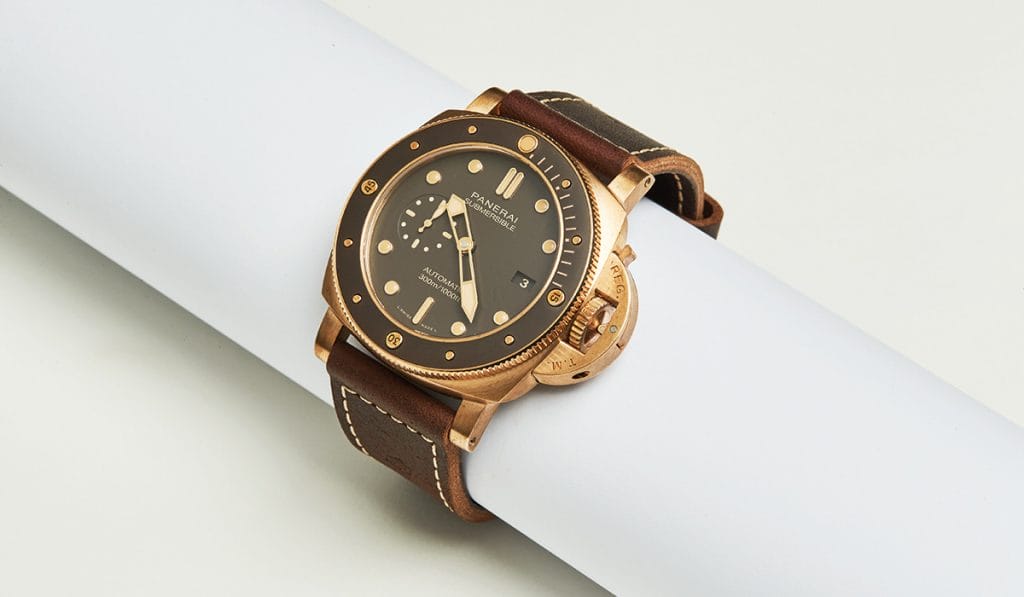Because this is an industry that takes pride in its adherence to the old ways, many of watchmaking’s innovations have been limited to materials technology to improve precision and performance. But after years of titanium, high-tech ceramic, silicon and carbon’s many composites, the latest trend comes from an unexpectedly old metal that predates even steel, and it’s the copper alloy we know as bronze. From the mind that gave the world its first luxury watch in steel, it’s not surprising that watch designer Gerald Genta was the one who first came up with the idea of casing a watch in bronze. The original 1984 model was known as the Gefica Safari, named after the three safari hunters who requested the watch (Geoffroy, Fissore and Canali). Bronze was chosen because its inability to reflect light kept the hunters better hidden.
What it does reflect these days is a certain amount of rebelliousness (it’s the furthest thing from precious, after all) and a hunger for personalisation. When the copper oxidises, it gains a unique patina, so the more copper the bronze has, the more obvious its natural or forced ageing. But in addition to the stories you can tell of a watch that ages with you, it’s also highly functional: It resists corrosion in seawater, is anti-magnetic and harder than stainless steel.
Genta’s watch was ahead of its time, so it wasn’t until Panerai brought attention back to the material 27 years later, in the form of the Luminor Submersible 1950 Bronzo, that fellow dive watch specialists took notice. But watchmaking’s Bronze Age really took hold once fellow big names like Zenith and Tudor joined the parade. These companies are master storytellers, and it was easy to capitalise on bronze’s role as a foil to luxurious metals because it tells the story of where you’ve been, not where you’re at.
In The Mix
There are myriad ways to make a copper alloy, with inclusions such as tin (the most common), nickel and even silicon to achieve various properties. For watchmaking, though, durability and colour are priorities, so these are the main types you’ll find:
Brass
Brass is an alloy of copper and zinc, with the most common types being composed of 5 to 45 per cent zinc (any higher and the alloy would be too unstable to use). Brass is typically a golden yellow but adding more copper gives it a red tinge, while more zinc will turn it silvery. Since zinc is cheap, brass watches can be found among more affordable brands.
Tin Bronze
This alloy is sometimes known as phosphor bronze, when 0.01 to 0.35 per cent of phosphorus is added to the copper and tin mix. Tin offers corrosion-resistance and tensile strength, while phosphorus increases wear-resistance and stiffness. Overall, an alloy known for toughness, which fits perfectly with brands like Panerai, which has been using this alloy since 2011.
Aluminium Bronze
This copper alloy comes with 5 to 12 per cent aluminium and is stronger than tin bronze. Its greater corrosion-resistance – thanks to aluminium’s protective qualities – makes this type of bronze ideal for seawater applications, which is why it is the case material of choice for diving watches like Tudor’s Black Bay Bronze. Like brass, aluminium bronze tends to be golden in colour and doesn’t darken that easily.
Need For Speed
Can’t wait for nature to do its thing? Try any or all of these methods to speed up the ageing process.
EXPOSE IT TO CHEMICAL FUMES
Ammonia or any kind of vinegar will do. Remove the strap and place the watch head in a sealable container, but raised away from the bottom (for example, place it atop a small, inverted cup). Carefully add the liquid to the container, seal it, and wait eight to 24 hours. If it requires more time, occasionally cleaning the watch with hot water will give you a more consistent patina pattern. The same can be done with mashed boiled eggs.
SOAK IT IN MILK
The ammonia levels in milk are too low for the fuming process to work effectively, but giving the watch a milk bath over several hours may give it a rainbow-like, iridescent patina.
DOUSE IT IN LIVER OF SULPHUR
Mix a few cups of water with a little liver of sulphur gel in one bowl. In another, prepare a similar volume of water with a couple tablespoons of baking soda. Using rubber gloves, submerge the watch in the sulphur bath and watch the bronze change. Once you’ve reached the desired level of patination, place it in the baking soda water to stop the process. Short cycles provide the best results.
GO FOR A SWIM
If your watch has decent water resistance, hit the water. Chlorinated swimming pool water and the salty seas will transform bronze in ways that range from subtle and bright to “rescued from a shipwreckâ€.
How to Care For Your Bronze Watch
What to do if you’re looking to keep patination under control.
If you want to “reset†the patina, apply toothpaste, or a paste made out of baking soda and lemon juice, and scrub until the original shine returns. Alternatively, give it a quick soak in undiluted vinegar.
If you just want to clean it, Panerai recommends washing the watch with warm water, then using a soft brush or cloth to dry it.
If you never want it to gain patina, buy a gold watch. The allure of a bronze watch is its ability to change, and the only way to prevent moisture and air from reacting with the metal is to never wear it.



